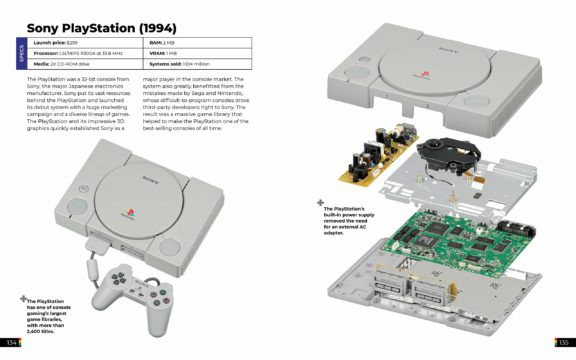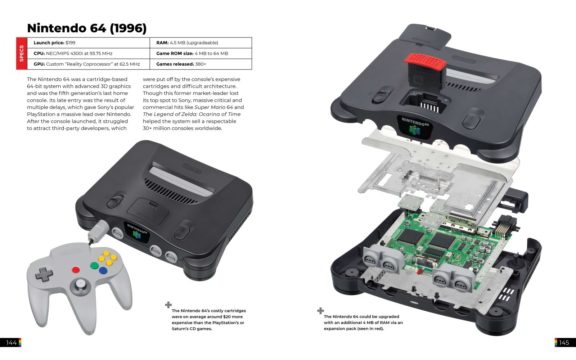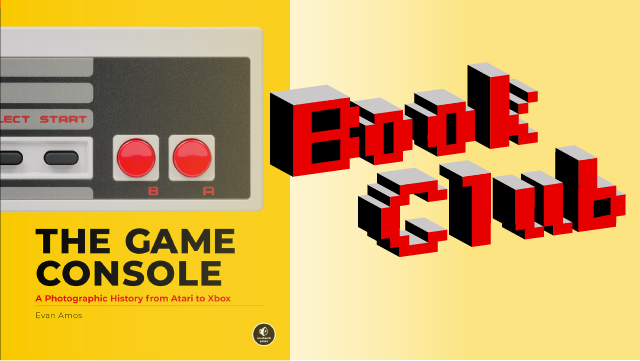Evan Amos might be one of the most dedicated video game fans of all time. In his book The Game Console: A Photographic History From Atari to Xbox, Amos reveals that his passion for writing about gaming hardware stemmed from his love of editing Wikipedia pages about them. Irked by the low-quality images that accompanied these articles, Amos, a hobbyist photographer, decided to start taking his own snapshots of each console and began uploading them onto the site. Since Wikipedia doesn’t allow for the use of images that aren’t royalty free, Amos had to find the consoles in the wild to get his pics— no easy task, there.
As Amos’ endeavor grew, he wanted to get hold of more and more hardware, eventually taking to crowdfunding in order to obtain rarer and more obscure pieces. All of this hard work has grown beyond Wikipedia into this delightful book that I was fortunate to get my hands on. The Game Console is an absolute love letter to the video game industry. Its bold, golden cover screams out to readers from the shelf, with the NES controller’s iconic form a promise of what awaits within. Thumbing through the book’s 264 pages won’t take very long (it took me about two days of on-and-off reading to complete), but that’s because The Game Console is more about its visuals than its writing.

As the title asserts, this is a photographic history, meaning Amos invests the bulk of his energy into the pictures and capturing the forms of the various consoles featured throughout. It’s a task that Amos clearly relished, as all of the photos are beautifully shot. The bright and clear images of everything from Atari 2600 to Nintendo 64 look brilliant. What’s more, Amos does cross sectional shots of many of the systems— every screw and circuit and wire is carefully pulled out from top to bottom, allowing readers a rare sight into the very systems that they’ve played over the years.
What’s of real value here isn’t just the chance to see classics like SNES and PlayStation on full display, but the oddities that many people likely never even knew existed. Seeing a Sega Genesis in all its pitch-black glory is great, but how many people have ever set eyes on an Atari Mirai? The system is little more than a shell that some suspect would have been produced as a partnership between Atari and SNK to launch a rebranded, western NeoGeo. Amos has gone through great pains to photograph not just what was released, but in some cases what never was.

Some might bemoan the lack of system variants (like special editions) and other versions that aren’t in The Game Console. It would have been nice to see Amos crack into things like developer units, for instance. There are a handful of different GameCubes that were used by devs back in the day, for example, not to mention multiple PlayStation 2 consoles with “TEST” emblazoned on the lid. For historical purposes, it might have been informative to include these systems. Yet, ultimately that would open a can of worms that may have weighed the book down. Amos’ restraint is arguably why the book is so focused and entertaining. It doesn’t get lost too much in the minutiae of the history it covers.
At the same time, while I can appreciate that Amos wasn’t trying to make the book about the writing, in some regards, I wish there was a little more text to soak in. Some entries barely scratch the surface behind the console being covered. Perhaps more disappointing is that there isn’t parity between all entries in terms of what information is covered. Not every console has the total number of software titles in its library listed, for instance, an omission that sometimes stands out while reading. Given how hard it can be to find those totals, it’s understandable, but with a project like this it would have enriched the final product even more to track down that information.
Regardless, that’s a quibble of a complaint at best. Trivial lacunas notwithstanding, The Game Console is a must for anyone curious about the history of the video game industry. Seeing the evolution of gaming hardware, in particular the controllers, is invaluable. Amos’ pictures are beautifully constructed, as is the layout of the book itself. No page is wasted. The large layouts are pleasing to the eye and have a delightful flow to them. Here’s hoping this isn’t the last time that gamers will be able to read a book by Amos; Wikipedia is great, but he needs to find a home writing about games on the printed page.
For more books about video games to read, please enjoy these other Book Club installments:




 ShareThis
ShareThis







Hoping to check this one out soon!